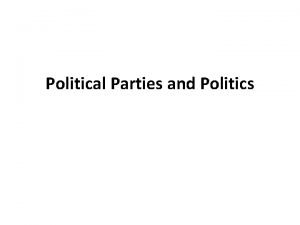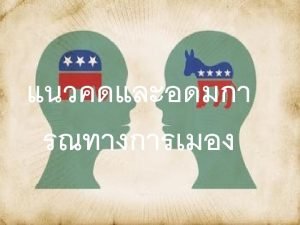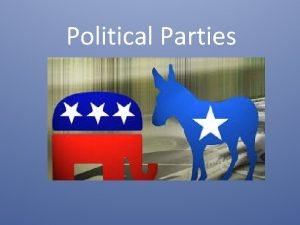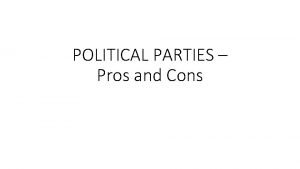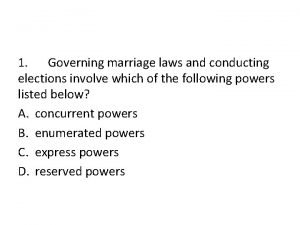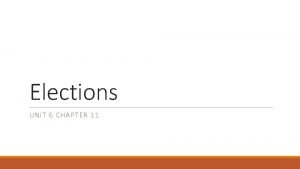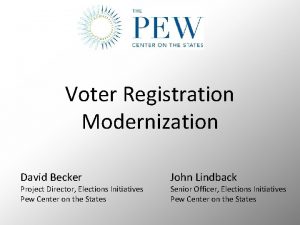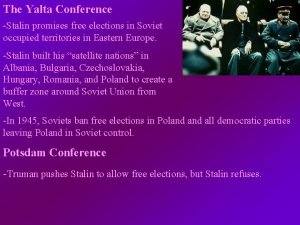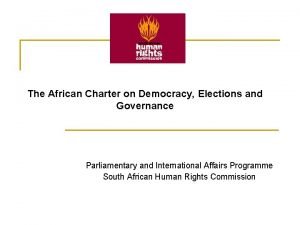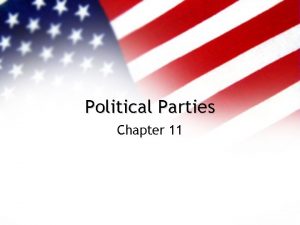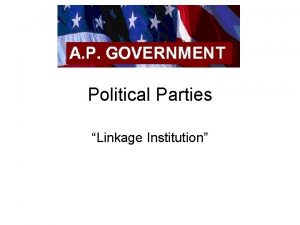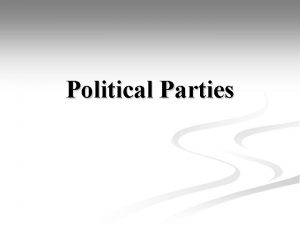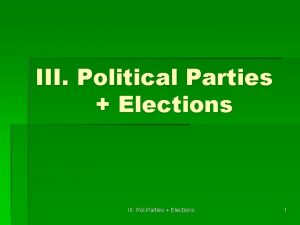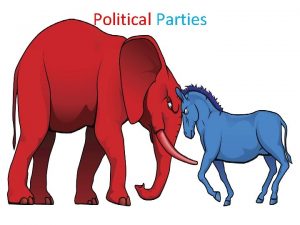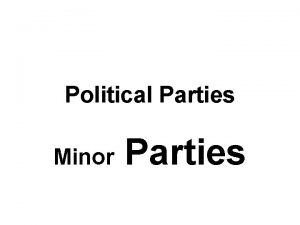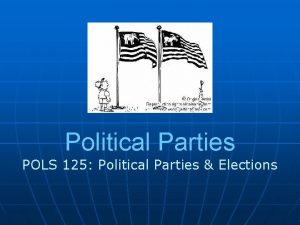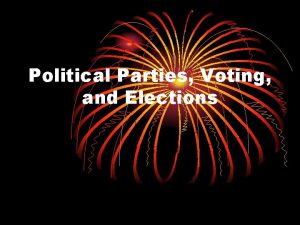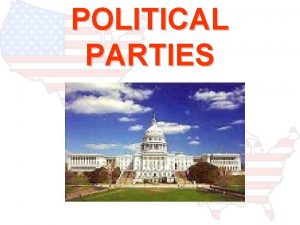Elections Political Parties What is a political party













- Slides: 13

Elections - Political Parties

What is a political party?

What is a political party? n A group of citizens who have similar ideas on issues and work together to put their ideas into government action. n The two major political parties are the Democrats and the Republicans

Liberal…. Liberals believe in governmental action to achieve equal opportunity and equality for all, and that it is the duty of the State to alleviate social ills and to protect civil liberties and individual and human rights. Believe the role of the government should be to guarantee that no one is in need. Believe that people are basically good. Emphasize the need for the government to solve people’s problems.

Conservative…. Conservatives believe in personal responsibility, limited government, free markets, individual liberty, traditional American values and a strong national defense. Believe the role of government should be to provide people the freedom necessary to pursue their own goals. Emphasize empowerment of the individual to solve problems.

Differences Between Political Parties n Democrats n n n Higher taxes Health care for everyone More gov’t regulation of business Government should be more involved in solving the nation’s problems. Usually liberal views

Differences Between Political Parties n Republicans n n n Lower taxes Private health care Less gov’t regulation of business Government should let people solve problems Usually conservative views

n The Democratic Party’s donkey and the Republican Party’s elephant have been on the political scene since the 19 th century. The origins of the Democratic donkey can be traced to the 1828 presidential campaign of Andrew Jackson. During that race, opponents of Jackson called him stubborn like a donkey. However, rather than rejecting the label, Jackson, a hero of the War of 1812 who later served in the U. S. House of Representatives and U. S. Senate, was amused by it and included an image of the animal in his campaign posters. Jackson went on to defeat incumbent. In the 1870 s, influential political cartoonist Thomas Nast helped popularize the donkey as a symbol for the entire Democratic Party. n The Republican Party was formed in 1854 and six years later Abraham Lincoln became its first member elected to the White House. An image of an elephant was featured as a Republican symbol in at least one political cartoon and a newspaper illustration during the Civil War (when “seeing the elephant” was an expression used by soldiers to mean experiencing combat), but the pachyderm didn’t start to take hold as a GOP symbol until Thomas Nast, who’s considered the father of the modern political cartoon, used it in an 1874 Harper’s Weekly cartoon. Titled “The Third-Term Panic, ” Nast’s drawing mocked the New York Herald, which had been critical of President Ulysses Grant’s rumored bid for a third term, and portrayed various interest groups as animals, including an elephant labeled “the Republican vote, ” which was shown standing at the edge of a pit. Nast employed the elephant to represent Republicans in additional cartoons during the 1870 s, and by 1880 other cartoonists were using the creature to symbolize the party.

Similarities of Political Parties n n Organize to win elections Influence public policies Reflect both liberal and conservative views Define themselves in a way to gain the support of the majority of people (political center)

Third Parties n Don’t usually win elections. n Introduce new ideas. n Focus on a particular issue. n Revolve around a political n personality. Examples: Tea Party, Reform Party, Green Party, Libertarian Party, etc.

What about you? Please take the ideological survey

21 -25 Liberal responses = Strong Liberal 16 -20 Liberal responses = Weak Liberal 21 -25 Conservative responses= Strong Conservative 16 -20 Conservative responses= Weak Conservative 10 -15 of either responses Moderate =

That’s All Folks!!!!!
 Political
Political What was one way progressives differed from populists
What was one way progressives differed from populists Wikimedia
Wikimedia Political parties
Political parties Political parties
Political parties Political parties
Political parties Political parties pros and cons
Political parties pros and cons Win the white house brainpop
Win the white house brainpop Third and fourth party logistics
Third and fourth party logistics Governing marriage laws and conducting elections
Governing marriage laws and conducting elections “elections are key to democracy”
“elections are key to democracy” David becker elections
David becker elections Stalin promise free elections
Stalin promise free elections African charter on democracy, elections and governance
African charter on democracy, elections and governance
